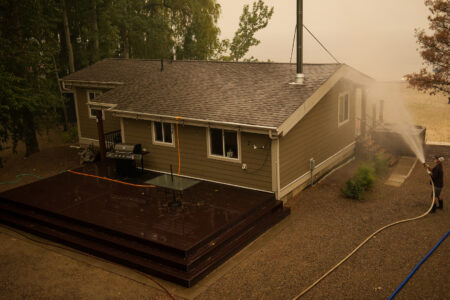
In the midst of the worst public health emergency in recent memory — with medical experts predicting a COVID-19 third wave — we can expect the public health response and vaccine rollout to be front and centre in this spring’s federal budget.
Budget 2021 must also invest decisively in solving the other planetary emergency — the global ecological crisis.
In the latter half of 2020, throughout Canada and worldwide, an idea was born that would do both. A “green and just recovery” is being advanced by civil society groups, as well as some political and business leaders. Its promise? To create the jobs, we need to rebuild our economies while also helping address the ever-worsening climate and biodiversity loss crises, with an approach centred on equity.
Through a coordinated campaign by a coalition of non-governmental organizations, in just four months, almost 200,000 people sent messages to the federal government advocating for a green and just recovery.
The message started to land.
In its September 2020 throne speech, the Liberal government promised climate action would be “a cornerstone” of a one-million-jobs plan. In November’s federal fall economic statement, Finance Minister Chrystia Freeland stated clear commitments to a “green transformation.”
We saw similar action internationally.
A February 2021 “Greenness of Stimulus Index” (GSI) report highlighted promising examples of jurisdictions seizing the opportunity. The European Union’s $1.1 trillion “Next Generation EU” stimulus plan, for example, will direct 37 per cent of funds to green initiatives, including measures to reduce fossil fuel dependence, enhance energy efficiency and preserve and restore natural capital. Plus, all recovery loans and grants to member states will have “do no harm” environmental safeguards attached.
December’s UN Emissions Gap Report stated that green recovery spending would be critical to limiting global warming to safe levels (of 2 degrees C).
Unfortunately, we’re not on track. The GSI report found, “governments to date have largely failed to harness this opportunity.”
How might a green and just recovery look for Canada?
There’s no doubt that the planned federal stimulus spending ($100 billion over three years) will have a significant impact on Canada’s carbon emissions and ecosystems. While these investments are intended to be time-limited, effects on climate and nature will be long lasting. Aligning Canada’s recovery plan with environmental outcomes will make recovery from the climate and biodiversity crises easier and less costly.
While government is expected to set out its recovery plan in the budget, Freeland referred to investments announced with the fall economic statement and government’s new climate plan as a “down payment.” This includes more than $30 billion in spending to create climate jobs and reduce emissions. For example — $4 billion on nature-based climate solutions like tree-planting; nearly $3 billion to support clean electricity and low-carbon fuels; and more than $16 billion for transit.
These are unprecedented and important times for the future of humanity. Will investments that create good jobs while addressing the ecological crisis be a footnote, or the central focus of Canada’s recovery strategy? Will Canada extend additional subsidies to, and prolong reliance on, fossil fuel extraction, or use this moment to accelerate the shift to a clean economy?
Despite broad support for a green and just recovery, some who are overly focused on debt and the inflation boogeyman would prefer government to slow stimulus investments, reducing green investments to half measures.
Last month, a group of Canada’s leading economists told Freeland to keep her eye on the deficit and not let it balloon out of control.
If a global pandemic paired with twin ecological crises aren’t enough to silence calls for austerity in recovery spending, what is?
Canada (alongside almost 1,900 other jurisdictions worldwide, including hundreds of Canadian municipalities) has declared a climate emergency. But are we acting (and spending) as if we’re in an emergency?
In his 2020 book, Canadian public policy consultant Seth Klein lays out the four markers that prove a government is in emergency mode. The first is “spend what it takes to win.” Likening Canada’s climate emergency response to our response to the Second World War, Klein shows that during the war, our debt-to-gross domestic product (GDP) ratio surpassed parity (reaching 108 per cent). Today, some are concerned that our debt-to-GDP ratio has reached less than half that, at only 49 per cent.
Klein also points to World Bank chief economist Nicholas Stern who argued before the pandemic that governments should spend two per cent of GDP on climate-mitigation efforts until the climate emergency is under control. For Canada, that’s works out to almost $50 billion annually.
Resistance to this level of spending is rooted in our traditional economic model and outdated indicators, emphasizing GDP growth and a low debt-to-GDP ratio, but paying no heed to indicators like the atmospheric concentration of greenhouse gas emissions or the rate of biodiversity loss. In 2021, this thinking is outdated.
Before the pandemic, Prime Minister Justin Trudeau gave Canada’s first Minister of Middle Class Prosperity — Mona Fortier — a mandate “to lead work to better incorporate quality of life measurements into government decision-making and budgeting, drawing on lessons from other jurisdictions such as New Zealand and Scotland.” Making Budget 2021 a Canadian well-being budget would be a foundational step toward optimizing economic decision-making in consideration of social foundations and environmental limits.
The numbers are appealing. Future job growth will be in the clean economy, not industries that are nearing their end like fossil fuels. With Canada’s planned one million green jobs, are we on the precipice of a new era?
The pandemic has reminded us of the importance of heeding the science, and the power of collective action in the face of an emergency. Let’s apply these lessons to the recovery agenda and seize this moment to truly rebuild better.
Photo : A woman walks her dogs along the beach by Lake Ontario as the sun rises in Toronto on February 10, 2021. THE CANADIAN PRESS/Frank Gunn








